Hispanic American Women Trailblazers
In honor of Women's History Month 2023,
Ms. Arteaga's AP Spanish students researched and wrote
biographies (in Spanish and English) of Hispanic American women
who were trailblazers in their fields.
Scroll down to read bios or click student names at top.
Claribel Alegría
(1924-2018)
by Evelyn Yee
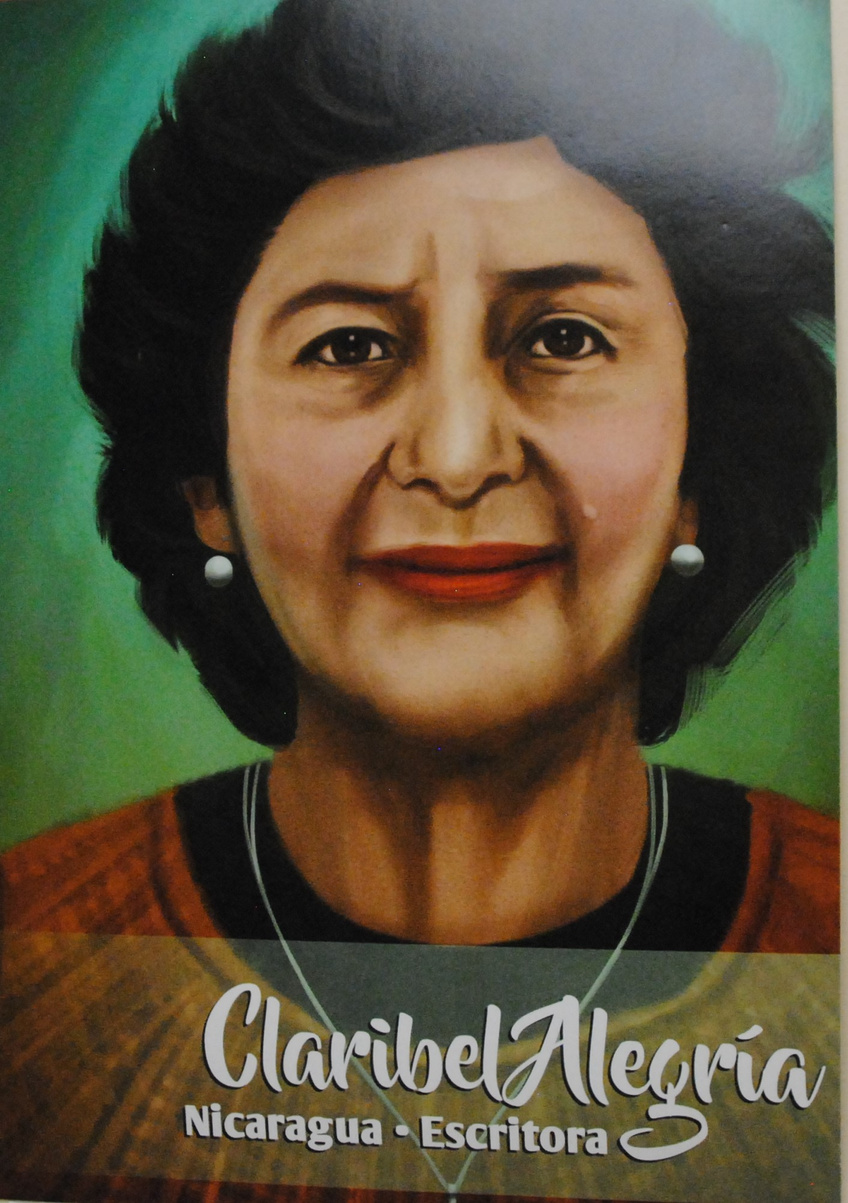
Claribel Alegría
by Evelyn Yee
Claribel Alegría, born as Clara Isabel Alegría Vides on May 12, 1924, was a Nicaraguan Salvadoran poet, essayist, novelist, and journalist whose work focused on the fight for human rights and justice for women. When she was younger, her father decided to move her family to El Salvador because of the civil war that would soon appear in Nicaragua. She began writing poems at age 6, and at 18 went to the United States where she studied at George Washington University. She graduated in 1943 with a degree in Philosophy and Letters. Later, in 1947, she married Darwin J. Flakoll, an American journalist and diplomat who also helped her write many of her works, such as Death of Somoza and They Won’t Take Me Alive. Some of her other works include Ashes of Izalco, Luisa in realityland, and Flowers from the volcano. Alegría died on January 25, 2018, in Managua, Nicaragua.
Claribel Alegría, nació Clara Isabel Alegría Vides el 12 de mayo de 1924, fue una poeta, ensayista, novelista, y periodista de Nicaragua y El Salvador cuyas obras se concentraron en la lucha de los derechos humanos y la justicia para las mujeres. Cuando era niña, su padre se decidió mudar a El Salvador por la guerra civil que pronto llegaría en Nicaragua. Ella empezó escribiendo poemas a la edad de 6 años, y a 18 fue a los Estados Unidos donde ella estudió en la universidad de George Washington. Ella se graduó en 1943 con un título en filosofía y las letras. Más tarde, en 1947, ella se casó con Darwin J. Flakoll, un periodista americano y diplomático quien también ayudarla escribir muchas de sus obras, como Death of Somoza y They Won’t Take Me Alive. Algunos de sus otras obras son Cenizas de Izalco, Luisa en el país de la realidad, y Flores del volcán. Alegría murió el 25 de enero de 2018, en Managua, Nicaragua.
Julia de Burgos
(1914-1953)
by Gabrielle Bourassa
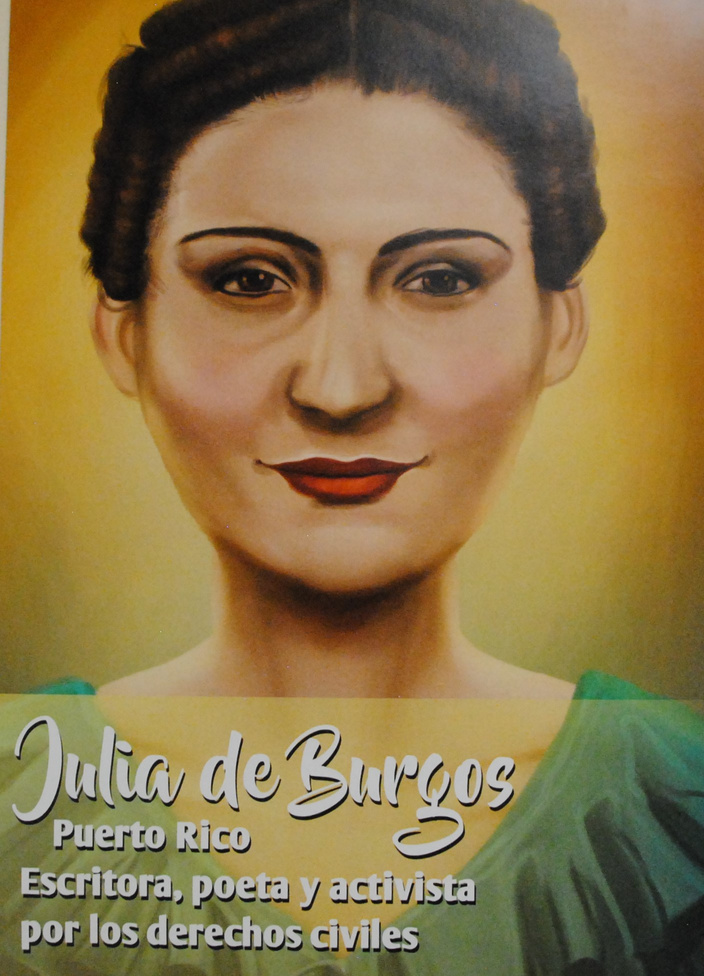
Julia de Burgos
by Gabrielle Bourassa
Julia Constanza Burgos Garcia was born in Santa Cruz, Carolina, in Peru on February 17th 1914. Her family was very large. She had 13 siblings and all of them lived in one house on a ranch. Out of all her siblings, Julia was the only to receive an elementary education. After that, she won a scholarship for her high school education. In high school, she found her passion for writing and literature. This passion motivated Julia to earn a degree in teaching at the University of Puerto Rico. After college, she taught for one year and in 1934, she stopped teaching to start civil rights work. For five years, she worked in civil rights and then whet back to college again. In 1939, she took a job in the US as a journalist. Here, Julia wrote a lot and in her final years, published three books of poems about oppression in Puerto Rico, her home country. In 1953, Julia died and her family brought her body back to Puerto Rico. Julia is remembered for her talent with words that helped the lives of so many Puerto Rican people.
Julia Constanza Burgos Garcia nació en Santa Cruz, Carolina, en Perú, 17 Febrero de 1914. La familia de ella era muy grande. Ella tuvo 13 hermanos y todos vivieron en una casa en un rancho. De todos sus hermanos, Julia fue la única que recibió una educación primaria. Después de este, ella ganó un escolaridad para educación secundaria. En su instituto, Julia encontró una pasión por escribir literatura. Esta pasión motivó a ella para obtener un título para enseñanza en la Universidad de Puerto Rico. Después de esto, ella trabajó en una escuela por un año y en 1934, paró su enseñanza y empezó con trabajo de derechos civiles. Por 5 años ella siguió con esto trabajo y después, fue a Universidad otra vez. En 1939, ella tomó un trabajo en los EEUU de periodista. Aquí, Julia escribió mucho y en sus años finales, ella publicó tres libros de poemas sobre opresión en Puerto Rico, su patria. En 1953, Julia murió y su familia se llevaron su cuerpo a Puerto Rico. Ella esta recordada por su talento con palabras que ayudaron las vidas de muchos puertorriqueños.
Frida Kahlo
(1907-1954)
by Emma Haher
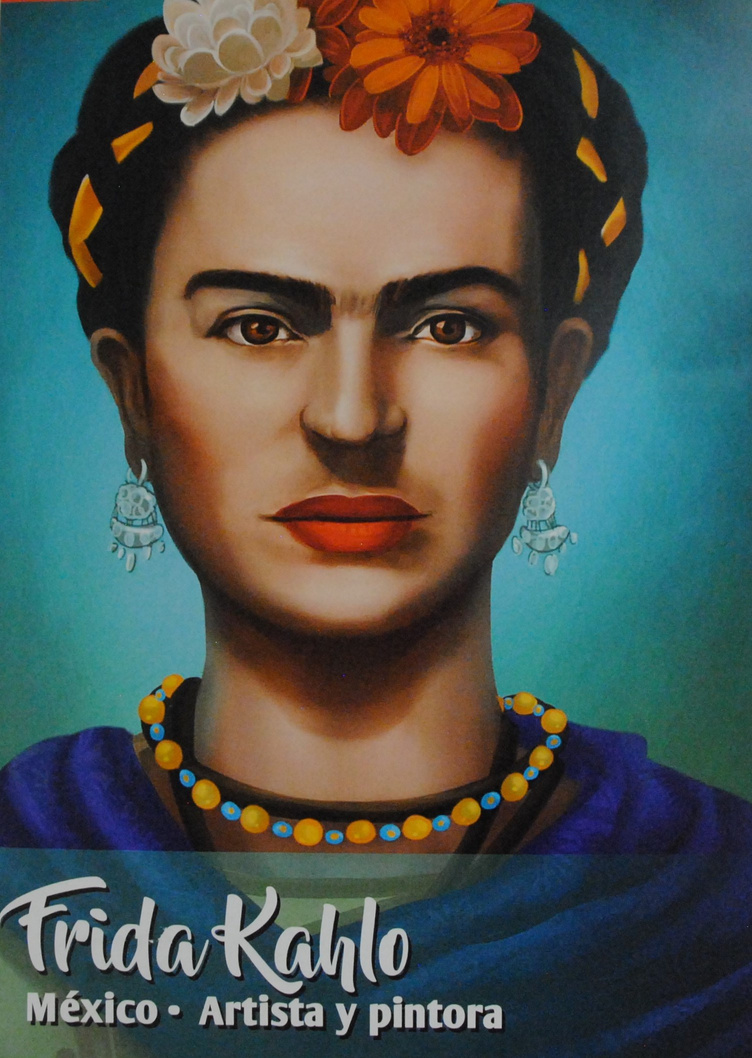
Frida Kahlo
by Emma Haher
Frida Kahlo was born in 1907 in Coyoacan, Mexico City, Mexico. Frida had 3 sisters. Her father was German, and her mother was half Indian-American and half Spanish. As a child, Frida was unhealthy and had Polio. She had a good relationship with her father, who encouraged her to participate in activities uncommon for girls to do. Frida went to the “National Preparatory School” in Mexico City, where she met the famous Diego Rivera. In 1922, Frida was in a bus crash. Frida fractured her pelvis and spine and had to wear a full body cast for 3 months. Frida occupied her time painting. She painted in her bed and liked to paint self-portraits. She later married Diego Rivera and moved with him for his work. Frida continued to paint, but had a sad life. Diego had many affairs, and Frida couldnt have children because of the accident. Frida was known for her self-portraits and surrealism. She had exhibits in Paris and New York. Some of her most famous paintings are “The Two Fridas” and “The Broken Column”. Later, Frida had depression and died of possible suicide at 47.
Frida Kahlo nació en 1907 en Coyoacán, Mexico City, Mexico. Frida tuve 3 hermanas. Su padre fue alemán, y su madre fue mitad Indio Americano, y mitad Español. De pequeña, Frida tuvo mala salud y tuvo Polio. Ella tuvo una buena relación con su padre, quien la animó a hacer actividades poco comunes para las niñas. Frida fue a la “National Preparatory School” en México City, donde ella se reunió con el famoso Diego Rivera. En 1922, Frida estuvo en un accidente de autobús. Frida fracturó su pelvis y columna y tuvo que llevar un elenco de todo el cuerpo por 3 meses. Frida ocupó su tiempo pintando. Ella pintaba en su cama y le gustaba pintarse a sí mismo. Frida se casó con Diego Rivera y se mudo con él por su trabajo. Frida continuó pintando, pero tuvo una vida triste. Diego tenía muchas aventuras y Frida no podía tener hijos por el accidente. Frida se conocía por su autorretrato y surrealismo. Ella tuvo exhibiciones en París y Nueva York. Algunas de sus pinturas más famosas son “The Two Fridas” y “The Broken Column”. Más tarde, Frida se deprimió y muere de posible suicido a 47.
Cristina Kirchner (1953-Present)
by Tara Gorman
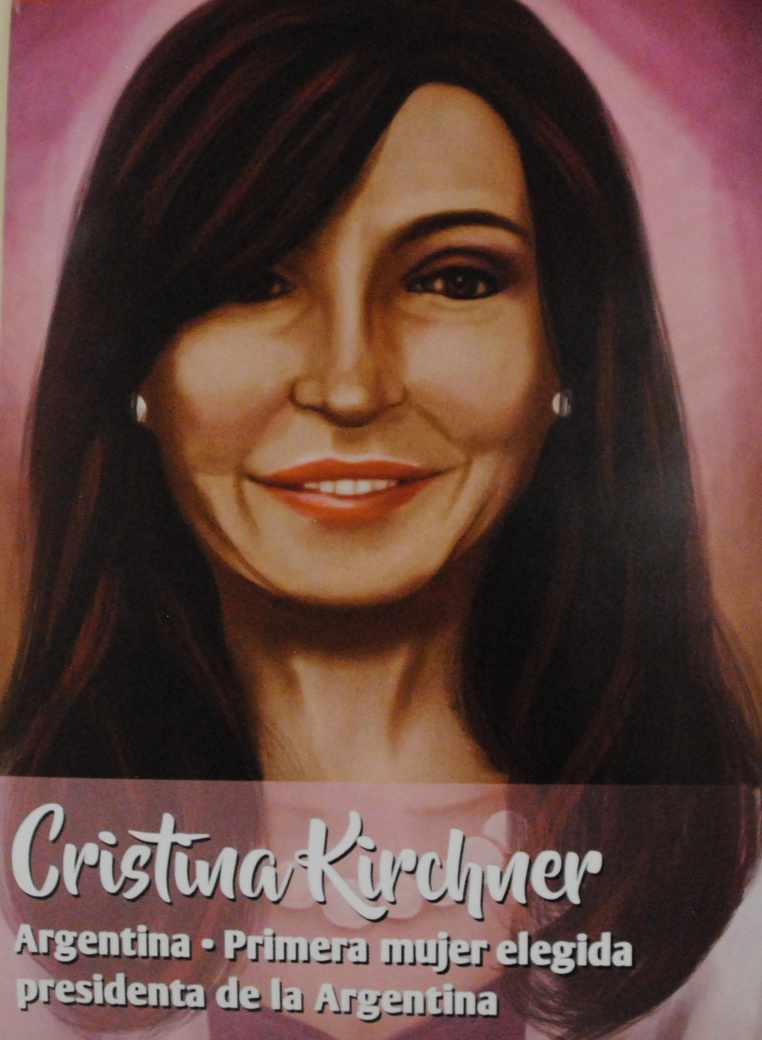
Cristina Kirchner
by Tara Gorman
Cristina Kirchner was born in 1953 in La Plata, the capital of Argentina. She married her husband, Nestor Kirchner in 1975. She began her political career in the late 1980s, first as a member of the Santa Cruz legislative body before being elected to the national Chamber of Deputies. Meanwhile, Nestor was elected governor of Santa Cruz, where they lived. He became president in 2003 and Cristina was a senator. In 2007, Cristina became president and was the first woman to be elected president of Argentina. She won re-election as well. While president, she tried to make advancements within human rights issues and legalized same-sex marriage. She also tried to increase social spending. She lost the 2015 elections, but in 2017 she was chosen by Alberto Fernández to be his vice president. In 2022, someone tried to assassinate her and many Argentinians stood up for her and protested against violence. She has announced that she will not run for president again in 2023 because of the violence and the corruption trial she is involved in.
Cristina Kirchner nació en 1953 en La Plata, la capital de Argentina. Ella se casó con su esposo, Nestor Kirchner en 1975. Empezó su carrera política en el final de la década de 1980, primero como miembro del cuerpo legislativo de Santa Cruz antes de ser elegida para la Cámara de Diputados nacional. Mientras tanto, Nestor fue elegido gobernador de Santa Cruz, donde vivían. Se convirtió en presidente en 2003 y Cristina fue una senadora. En 2007, Cristina se convirtió en presidente y fue la primera mujer elegida presidenta de la Argentina. Ella ganó la reelección también. Mientras era presidenta, trató de hacer avanzar los derechos humanos y legalizó el matrimonio entre personas del mismo sexo. también trató de aumentar el gasto social Ella perdió las elecciones de 2015, pero en 2017 fue elegida por Alberto Fernández para ser su vicepresidenta. En 2022, alguien intentó asesinarla y muchos argentinos protestaron por ella contra la violencia. Ella ha anunciado que no volverá a postularse para presidente en 2023 porque la violencia y el juicio por corrupción en el que estuvo.
Rigoberta Menchu Tum
(1959-Present)
by Nithya Vuppalapati
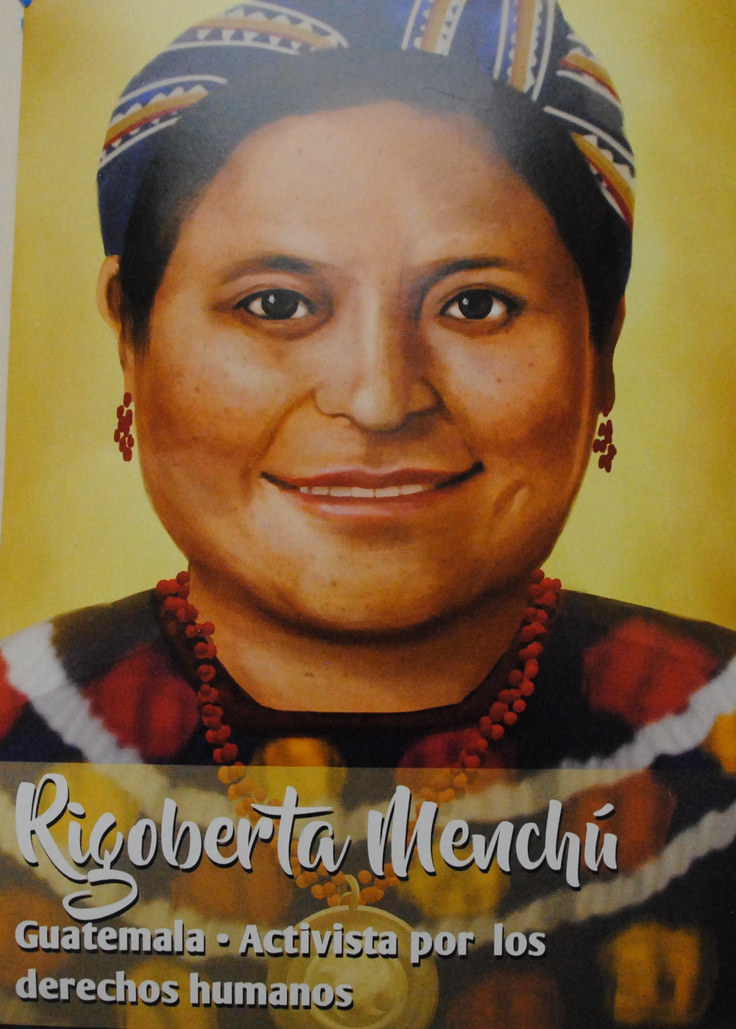
Rigoberta Menchu Tum
by Nithya Vuppalapati
Rigoberta Menchu Tum was born in Aldea Chimel, Guatemala in 1959 on January 9th to a peasant family. She is part of the Quiche branch of the Mayan culture, her family worked on coffee plantations. As a teenager, she was heavily involved in the women's rights movement. She and her family are part of the Committee of the Peasant Union, and many of her family members were arrested and tortured after they were accused of working against the government. She helped organize and participated in many strikes for Peasant Rights in Guatemala. She taught herself many languages including Spanish (Her first language was Quinche). She wrote her life story, I, Roberta Menchu in 1983. She now lives in Mexico for safety from death threats, but she continues to fight for the rights of tribes in Guatemala. In 1992, Rigoberta Menchu Tum was awarded the Nobel Peace prize for her bravery and dedication for fighting for civil rights of her community in Guatemala and beyond.
Rigoberta Menchu Tum nació en Aldea Chimel Guatemala el 9 de enero de 1959 por una familia pobre. Ella es una miembro de Quinche (una parte de cultura Maya) y su familia trabaja en plantaciones de café. Cuando era adolescente, ella participaba mucho en los movimientos por los derechos de las mujeres. Ella y su familia son parte de Committee of Peasant Union y muchos miembros de su familia fueron detenidos y torturados porque el gobierno los acusó por trabajar en contra de la ley. Ella organiza y participa en muchas huelgas por los Derechos de los Campesinos en Guatemala. Ella aprendió muchas lenguas, incluyendo español. Ella escribe la historia de su vida en su novela I, Roberta Menchu en 1983. Ella ahora vive en México para seguridad de amenazas de muerte pero ya continua peleando por los derechos de su gente. En 1992, Rigberta Menchu Tum asigna al Nobel Peace Prize por su valor y compromiso por su pelea por derechos civiles por su comunidad en Guatemala y más.
Ellen Ochoa
(1958-Present)
by Anjali Sangappa
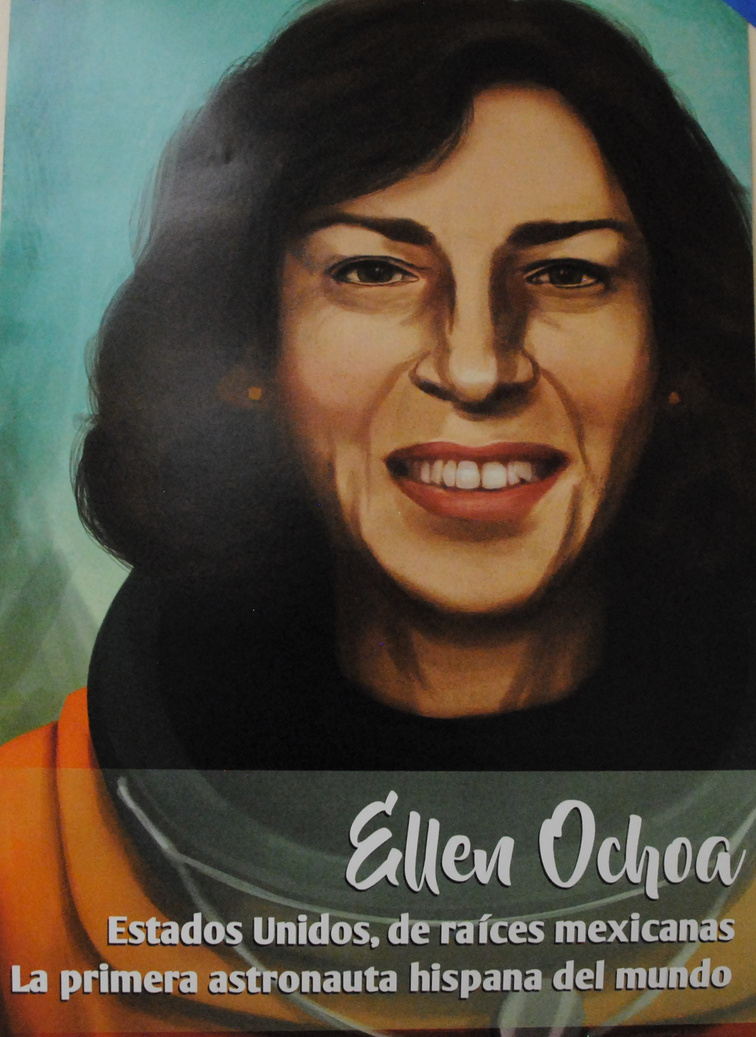
Ellen Ochoa
by Anjali Sangappa
Dr. Ellen Ochoa is known as the first hispanic astronaut in the world. She is from the United States, and of Mexican descent. She was born in Los Angeles, California. After receiving a doctorate in electrical engineering from Stanford in 1985, she worked as an engineer for NASA. In 1991, she completed her training to be the first hispanic female astronaut. In 1993, she was the first Hispanic woman to travel to space. She was the director of the Johnson Space Center, and now she is the vice chair of the National Foundation of Science. In April of 1993, she served as a mission specialist in the mission “STS-56”, which studied the Sun and its interactions with the Earth. In May of 1999, she was a member of the crew “Discovery STS-96” which executed the first docking in the International Space Station. In total, Ochoa has spent 40 days in space. Ellen Ochoa has many accomplishments for both the Hispanic community and the field of space exploration.
Dr. Ellen Ochoa es conocida como la primera astronauta hispana del mundo. Ella es de los Estado Unidos, y de raíces Mexicanas. Ella nació en Los Angeles, California. Después de recibir un doctorado en ingeniería eléctrica de Stanford en 1985, ella trabajó como ingeniera por la NASA. En 1991, ella completó su entrenamiento para ser la primera mujer hispana astronauta. En 1993, ella fue la primera mujer hispana en viajar al espacio. Ella fue la directora por el Johnson Centro de Espacio, y ahora ella es la asistente presidente de la Fundación Nacional de Ciencia. En abril del año 1993 ella sirvió como un misión especialista en la misión “STS-56”, la cual estudió el Sol y sus interacciones con la Tierra. En mayo del año 1999, ella fue miembro del equipo “Discovery STS-96” que ejecutó el primer barco atracado en la Estación Espacial Internacional. En total, Ochoa ha pasado 40 días en el espacio. Ellen Ochoa tiene muchos logros para ambos la comunidad de Hispanas y el campo de exploración espacial.
Eva Perón
(1919-1952)
by Samantha Hill
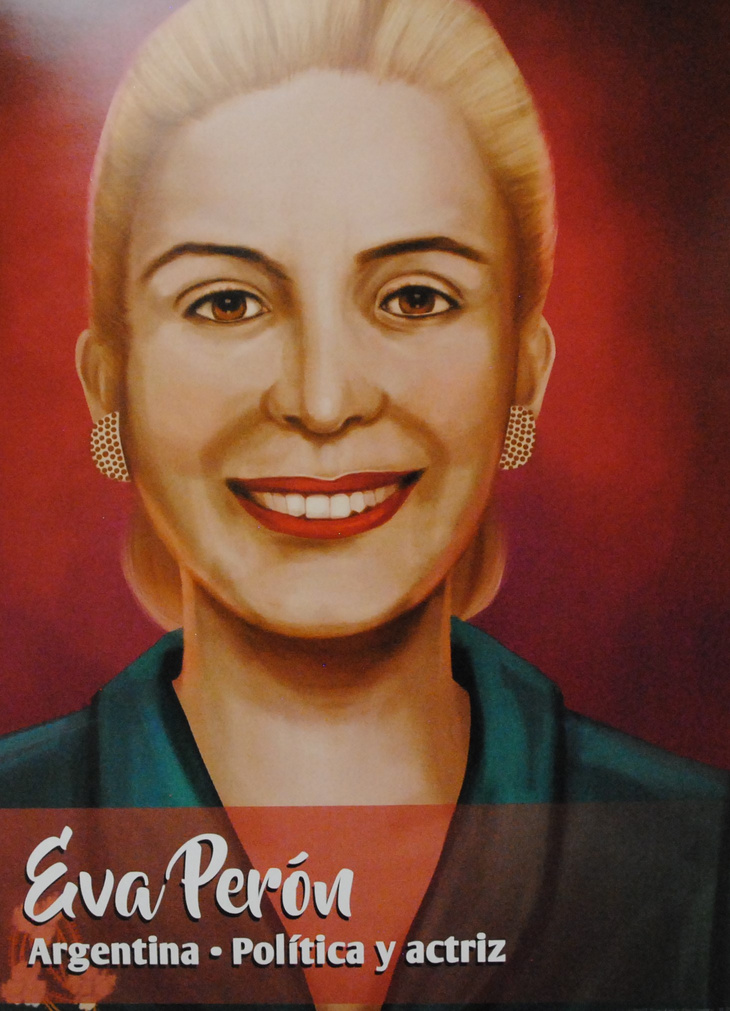
Eva Perón
by Samantha Hill
Eva Perón was a politician, actress, and First Lady of Argentina. She was born in 1919 in the Pampas of Argentina. Her family suffered financial difficulties, especially after the death of her father when Eva was six years old. She moved to Buenos Aires when she was 15 to become an actress. She married Colonel Juan Perón, who became the president in 1946. She never held office in an official capacity, but she was the de facto minister of labor and health during her husband’s presidency. She created the Eva Perón Foundation after defunding the Aid Society. With her new foundation, she did a lot of charity and helped the people of Argentina very much. She tried to run for vice president in 1951, but the army forced her to end her campaign. She died in 1952 of cervical cancer, and Argentina mourned. She was a great symbol of feminism in Latin American countries.
Eva Perón era una política, actriz, y la Mujer Primera de Argentina. Ella nació en 1919 en las Pampas de Argentina. Su familia sufría dificultades económicas, especialmente después del muerte de su padre cuando Eva tenía seis años. Ella se mudó a Buenos Aires cuando tenía 15 años para hacerse una actriz. Se casó con el Colonel Juan Perón, quién se hizo presidente en 1946. Ella nunca tuvo una oficina en una capacidad oficial, pero era la ministra de labor y salud de facto durante la presidencia de su esposo. Ella creó su Fundación de Eva Perón después de tomar los fondos de la Sociedad de Beneficencia. Con su fundación nueva, ella hacía mucha caridad y ayudaba a la gente de Argentina mucho. Ella trató de postularse por la oficina de la vicepresidencia en 1951, pero el ejército le obligó a terminar su candidatura. Ella murió en 1952 de cáncer cervical, y Argentina lloraba. Ella fue un gran símbolo de feminismo en los países latinoamericanos.
Sonia Sotomayor
(1954-Present)
by Eva Velasquez
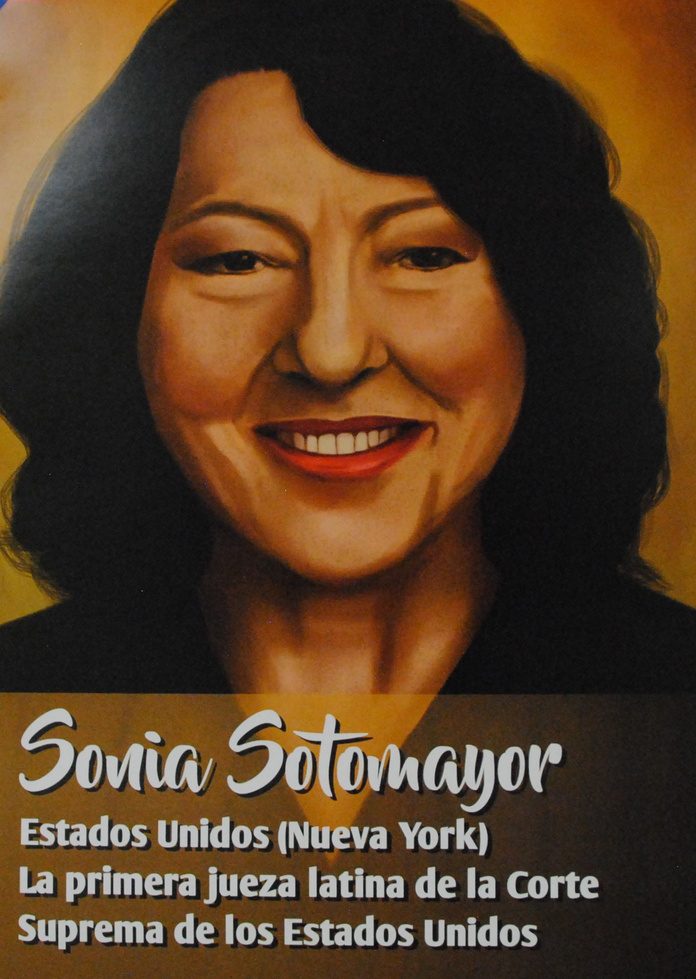
Sonia Sotomayor
by Eva Velasquez
Sonia Maria Sotomayor is a Puerto Rican lawyer and jurist who serves as an associate justice of the Supreme Court of the United States. She was nominated by President Barack Obama on May 26, 2009, and has served since August 8, 2009. She is the third woman, first woman of color, the first Hispanic, and first Latina to serve on the Supreme Court. She was born in the Bronx, New York to Puerto Rican parents on June 25, 1954. Sonia Sotomayor has become a role model, inspiration, and symbol for many Americans throughout the country. During her Supreme Court tenure, Sotomayor has expressed concern for the rights of defendants and criminal justice reform. She is best known for her passionate dissents and opinions on issues of race, ethnic, and gender identity. She is known for her outspoken advocacy for the Puerto Rican-American community and Hispanic community at large and continues to serve on the United States Supreme Court as its 111th justice in US history.
Sonia Maria Sotomayor es una jueza y jurista puertorriqueña quien se desempeña como jueza asociada de la Corte Suprema de los Estados Unidos. Fue nominada por el presidente Barack Obama el 26 de mayo de 2009 y se ha desempeñado desde el 8 de agosto de 2009. Es la tercera mujer, la primera mujer de color, la primera hispana, y la primera latina en servir en la Corte Suprema. Nació en el Bronx, Nueva York de padres puertorriqueños el 25 de junio de 1954. Sonia Sotomayor se ha convertido en un modelo a seguir, inspiración y símbolo para muchos estadounidenses en todo el país. Durante su mandato en la Corte Suprema, Sotomayor ha expresado preocupación por los derechos de los acusados y la reforma de la justicia penal. Es mejor conocida por sus apasionadas disidencias y opiniones sobre cuestiones de raza, etnia e identidad de género. Es conocida por su franca defensa de la comunidad puertorriqueña-estadounidense y la comunidad hispana en general y continúa sirviendo en la Corte Suprema de los Estados Unidos como su juez número 111 en la historia de los Estados Unidos.